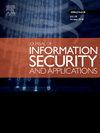通过图像重建揭示真实样本的紧密性,用于深度伪造检测
IF 3.7
2区 计算机科学
Q2 COMPUTER SCIENCE, INFORMATION SYSTEMS
Journal of Information Security and Applications
Pub Date : 2025-08-25
DOI:10.1016/j.jisa.2025.104201
引用次数: 0
摘要
深度造假对社会和网络安全的威胁不断升级,引发了公众的焦虑,人们越来越多地致力于深度造假检测这一关键研究。现有模型的泛化能力面临严峻挑战。一种普遍的解释是,模型倾向于过度拟合假样本中的人工制品,从而忽略了对可用真实样本的探索。先前的研究表明,真实图像在潜在特征空间中表现出类内聚类和类间均匀性,称为紧密性。由于深度伪造破坏了这一性质,探索真实样本的共同紧致性可能会促进模型的泛化。鉴于此,本文提出了一种有针对性的Compact Reconstruction Learning (CRL)策略。它应用增强的多视图重建损失(用于自紧致)来重建真实图像,并应用新的真实样本紧致损失(用于其他紧致)来加强真实样本之间的联系。此外,引入了一种新的联合引导推理(JointGR)模块,该模块丰富地融合了编码器-解码器的特征并重构了差异。它充分利用了CRL的多源特性,同时提高了我们模型的表示能力。在最新的基准测试下,大量的实验表明,我们的模型在大多数具有挑战性的数据集上保持了具有竞争力的性能,甚至在一些数据集上取得了最先进的结果。代码将在https://github.com/Dongyu-Han/CRL上开源。本文章由计算机程序翻译,如有差异,请以英文原文为准。
Revealing the compactness of real samples via image reconstruction for deepfake detection
The escalating threats posed by deepfakes to society and cybersecurity have triggered public anxiety, and growing efforts have been devoted to this pivotal research on deepfake detection. The generalization capability of existing models encounters a serious challenge. A prevailing explanation is that models tend to overfit artifacts in fake samples, thereby neglecting the exploration of available real ones. Prior studies have indicated that real images exhibit intra-class clustering and inter-class uniformity in the latent feature space, termed as compactness. Since deepfakes disrupt this property, exploring the common compactness of real samples may boost the generalization of models. In light of this, this paper proposes a targeted Compact Reconstruction Learning (CRL) strategy. It applies an enhanced Multi-View Reconstruction Loss (for self-compactness) to reconstruct only real images and a new Real-Sample Compactness Loss (for other-compactness) to bolster ties across real samples. Besides, a novel Joint-Guided Reasoning (JointGR) module is introduced, which richly fuses features from the encoder-decoder and reconstructed differences. It fully capitalizes on multi-source features from CRL while improving the representational ability of our model. Under the latest benchmark, extensive experiments show our model keeps the competitive performance on most challenging datasets, even achieving state-of-the-art results on some. The code will be open-sourced at https://github.com/Dongyu-Han/CRL.
求助全文
通过发布文献求助,成功后即可免费获取论文全文。
去求助
来源期刊

Journal of Information Security and Applications
Computer Science-Computer Networks and Communications
CiteScore
10.90
自引率
5.40%
发文量
206
审稿时长
56 days
期刊介绍:
Journal of Information Security and Applications (JISA) focuses on the original research and practice-driven applications with relevance to information security and applications. JISA provides a common linkage between a vibrant scientific and research community and industry professionals by offering a clear view on modern problems and challenges in information security, as well as identifying promising scientific and "best-practice" solutions. JISA issues offer a balance between original research work and innovative industrial approaches by internationally renowned information security experts and researchers.
 求助内容:
求助内容: 应助结果提醒方式:
应助结果提醒方式:


